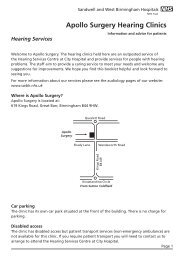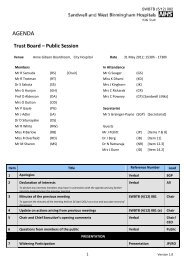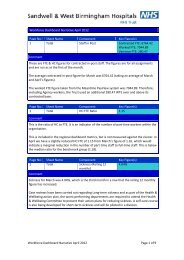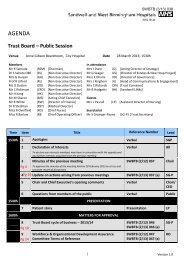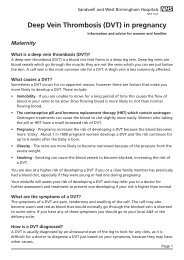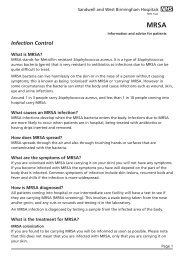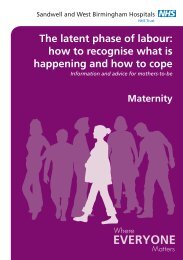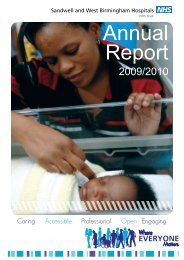January 2012 - Sandwell & West Birmingham Hospitals
January 2012 - Sandwell & West Birmingham Hospitals
January 2012 - Sandwell & West Birmingham Hospitals
Create successful ePaper yourself
Turn your PDF publications into a flip-book with our unique Google optimized e-Paper software.
SWBTB (1/12) 286 (a)<br />
Cluster Directors of Commissioning Development and with the Strategic Health Authority<br />
(SHA) confirmed that although these processes are linked, our reconfiguration process<br />
should continue on the basis that:<br />
a significant momentum has already been achieved,<br />
the reconfiguration of our stroke services could form a helpful ‘first piece in the jigsaw’<br />
which the <strong>Birmingham</strong> configuration could then build upon and<br />
there is an imperative to improve the quality of this stroke service for local patients to<br />
deliver better outcomes.<br />
The Black Country Cluster Clinical Senate received a report in December 2011 from the<br />
Black Country Cardiovascular Network on stroke services across the Black Country. A key<br />
recommendation of that report was “the need for a formal review of the provision of hyperacute<br />
stroke services across the Black Country Cluster…. And whether a review in the Black<br />
Country should form part of a wider <strong>West</strong> Midlands review, as patient flows impact on<br />
providers outside the Black Country Cluster.” The relationship of our proposed reconfiguration<br />
will relate to any future Black Country review in a similar way as to the <strong>Birmingham</strong> Cluster<br />
review.<br />
2.3 Local Context<br />
In October 2010 a peer review visit by the <strong>West</strong> Midlands Quality Review Service (WMQRS)<br />
to look at our Stroke Services raised concerns about the long term sustainability of<br />
maintaining high quality acute Stroke Services on both City and <strong>Sandwell</strong> Hospital sites that<br />
are able to robustly meet the standards identified for Stroke Services. It stated:<br />
“The sustainability of the current configuration of services should be considered. Achieving<br />
the expected Quality Standards on two hospital sites will be difficult given current staffing<br />
levels. The health economy may wish to consider the improvement in quality, and expected<br />
outcomes, which could be achieved by providing acute stroke care on one hospital site.<br />
Improving the availability and speed of response of imaging services will be an important part<br />
of this consideration.”<br />
We had also undertaken some work internally that identified similar concerns. Whilst acute<br />
stroke and TIA services are currently provided at <strong>Sandwell</strong> and City Hospital sites, the type of<br />
service provision and activity varies between the sites. For example:<br />
<br />
<br />
<br />
<br />
<br />
<br />
<br />
In-patient bed facilities and configurations differ<br />
Consultant cover differs on both sites<br />
Nursing configurations and competencies differ<br />
Delivery of Care pathways is not mirrored<br />
Imaging times and facilities and staffing differs<br />
Therapy input is managed differently<br />
Approach to rehabilitation and early supportive discharge differs.<br />
Table 1 below summarises the total number of patients we admitted during 2010/11 with a<br />
main diagnosis of stroke or a main diagnosis of TIA and the number of patients seen as<br />
outpatients with a TIA.<br />
Table 1 – Number of patients seen by SWBH for stroke and TIA in 2010/11<br />
Trust City Hospital <strong>Sandwell</strong> Hospital<br />
Stroke – patients 625 338 287<br />
admitted<br />
TIA – patients admitted 201 121 80<br />
6




